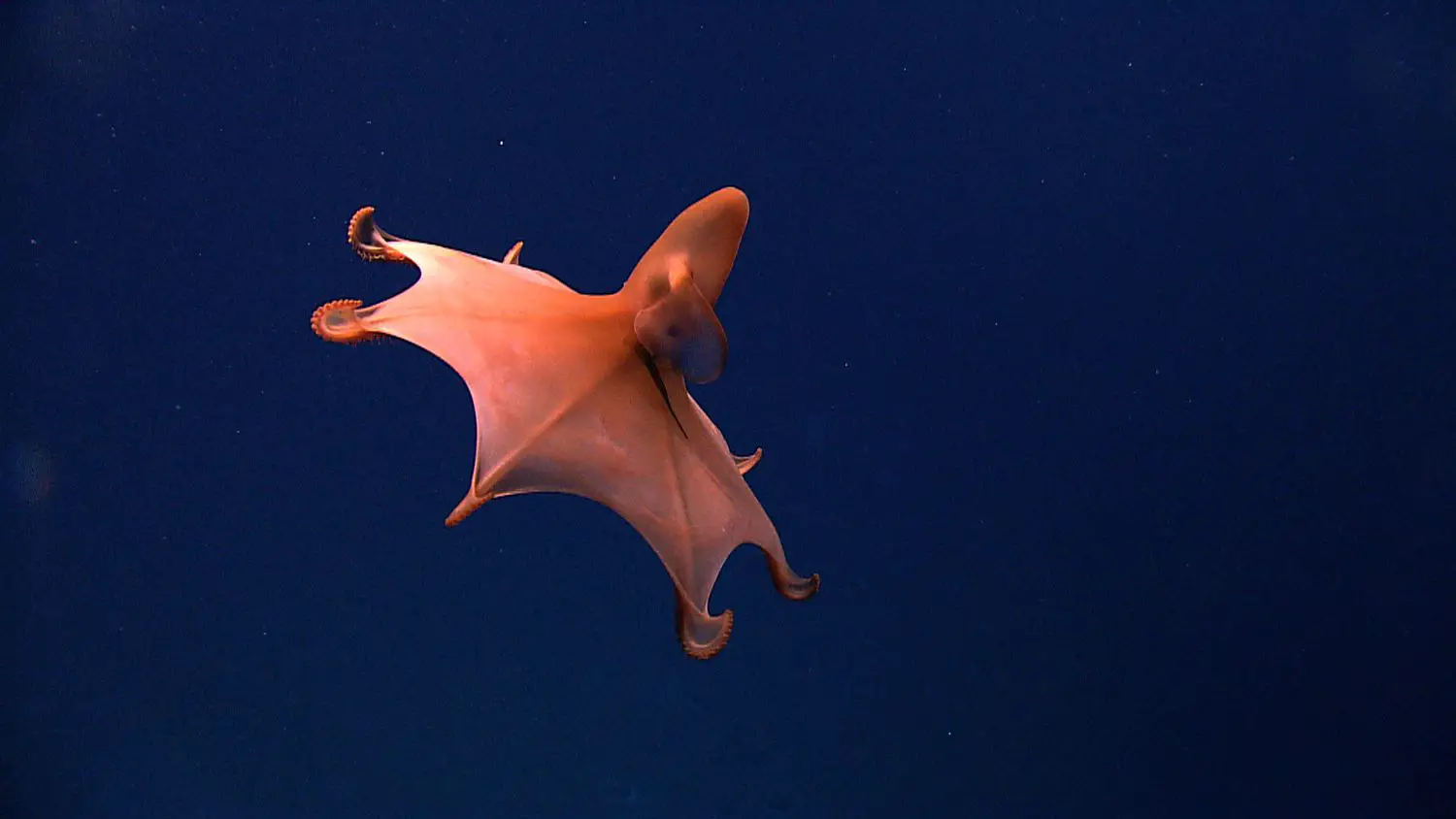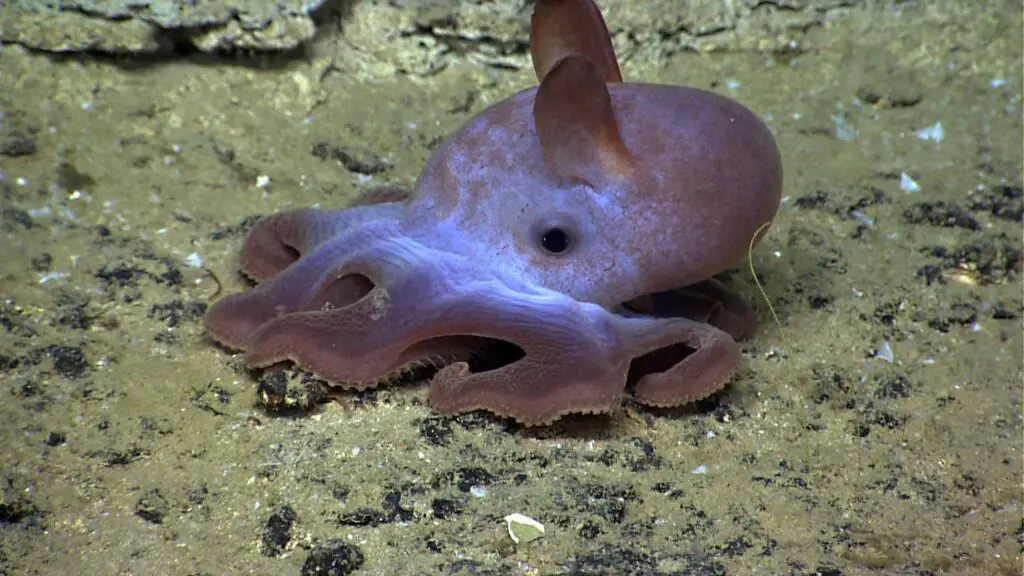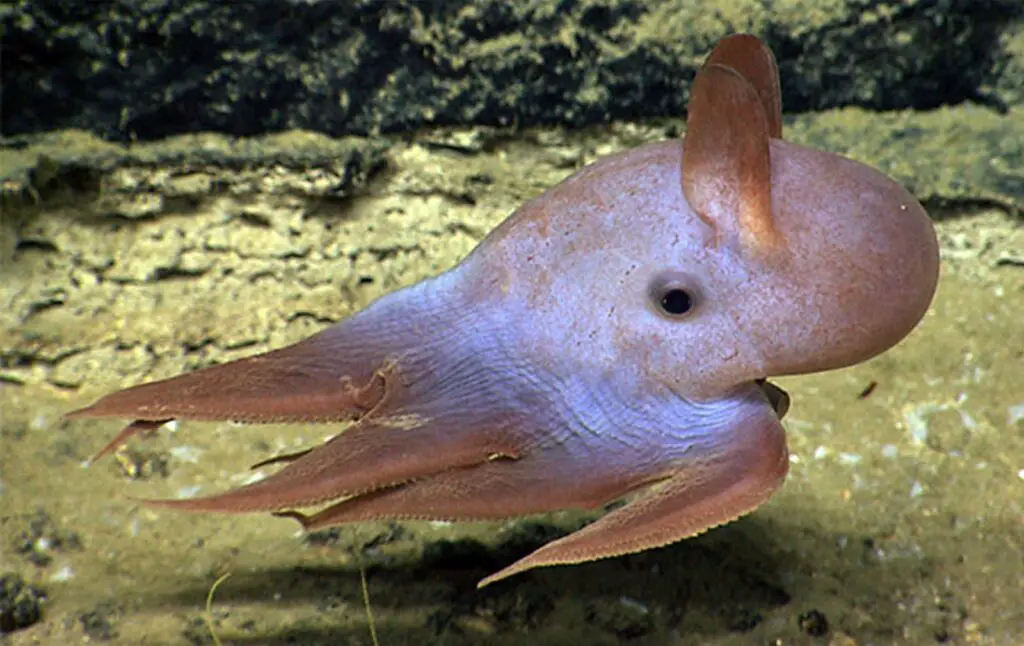Where Do Dumbo Octopus Live

Introduction
Where Do Dumbo Octopus Live: The Dumbo octopus, a remarkable and enigmatic creature, resides in one of the most extreme and inaccessible environments on Earth: the deep ocean acidification. Unlike their more common shallow-water relatives, Dumbo octopuses are uniquely adapted to thrive in the abyssal depths of the world’s oceans.
These fascinating cephalopods are named after the beloved Disney character, Dumbo the flying elephant, due to their ear-like fins that resemble Dumbo’s ears. While they lack the propulsive jet propulsion system found in other octopus species, Dumbo octopuses have evolved into expert drifters, relying on their delicate, ear-like fins to gracefully navigate the ocean’s depths.
Their preferred habitat lies thousands of meters below the surface, in regions known as the abyssal plains. These vast expanses of the deep sea are characterized by extreme pressure, frigid temperatures, and perpetual darkness. Yet, it is within this seemingly inhospitable realm that Dumbo octopuses make their home.
To survive in such harsh conditions, these creatures have developed a suite of adaptations, from their gelatinous bodies that can withstand immense pressure to their large, sensitive eyes that help them detect prey in the darkness. They are opportunistic predators, feasting on various marine organisms, including crustaceans and small fish that inhabit the abyssal plains.

Where do dumbo octopus live in the world?
Though it is believed that the dumbo octopus could be living worldwide, species have been found off the coast of California, Oregon and in the Gulf of Mexico, as well as Australia, the Azores, Papua New Guinea, the Philippines and New Zealand.
Dumbo octopuses, scientifically classified under the genus Grimpoteuthis, primarily inhabit the world’s deep oceans. These elusive cephalopods are found in various ocean basins, including the Atlantic, Pacific, and Indian Oceans, as well as the Southern Ocean. Their distribution spans a wide range of latitudes and longitudes, but their preferred habitat is the abyssal plains, which can extend as deep as 7,000 meters (23,000 feet) below the ocean’s surface.
One of the remarkable features of Dumbo octopuses is their adaptability to different depths and environmental conditions within the deep sea. They can be found at various levels of the water column, depending on factors such as prey availability and temperature. Some species of Dumbo octopuses are known to dwell near hydrothermal vents, where they may encounter unique ecological niches and extreme conditions.
Their wide-ranging distribution across the world’s oceans reflects the incredible diversity of this species and their ability to thrive in some of the most extreme and uncharted environments on Earth. Despite their remote and challenging habitat, scientists continue to study these fascinating creatures to uncover more about their biology, behavior, and role in deep-sea ecosystems.
Where do dumbo octopus eat?
Dumbo octopuses pounce on prey and eat it whole. Their diet includes copepods, isopods, bristle worms, and amphipods. Much of the food they consume is also found around ocean vent ecosystems or floating along in the current.
Dumbo octopuses are opportunistic predators that primarily feed on various marine organisms found in their deep-sea habitats. Their diet includes a variety of small prey, which they capture using their specialized adaptations for life in the abyssal depths.
These unique octopuses have well-developed sensory organs, particularly their large eyes, which enable them to detect faint traces of bioluminescent organisms and potential prey in the near-total darkness of the deep ocean. They also possess elongated, slender arms equipped with tiny suckers, which they use to grasp and manipulate their prey.
Dumbo octopuses primarily feed on crustaceans, such as shrimp and small crabs, and also consume small fish when the opportunity arises. Their diet may vary depending on the availability of prey in their particular deep-sea habitat.
One interesting aspect of their feeding behavior is their method of engulfing prey whole. With their soft, gelatinous bodies, Dumbo octopuses can expand their mouths to accommodate relatively large prey items, allowing them to swallow their food whole rather than tearing it into smaller pieces.
As deep-sea scavengers, they may also feed on carrion or detritus that sinks from higher in the water column, taking advantage of whatever sustenance drifts down to their habitat in the abyssal plains. This feeding strategy reflects their ability to adapt to the challenging and resource-limited environment of the deep ocean.
Can you have a dumbo octopus as a pet?
A dumbo octopus typically lives only around 3 to 5 years, making them invisible as pets, or as captive animals – in addition to the fact that they cannot survive outside of the highly pressurised waters of the deep sea: that’s why you’ll never find one in an aquarium or a pet store.
Dumbo octopuses are deep-sea creatures that inhabit extreme environments in the ocean’s abyssal depths, typically at depths of thousands of meters. These unique cephalopods have evolved specialized adaptations to survive in these conditions, including the ability to withstand high pressure, cold temperatures, and complete darkness.
Attempting to keep a Dumbo octopus as a pet would be both ethically and practically problematic. First, capturing these deep-sea animals would require specialized equipment and permits, and such activities can disrupt fragile deep-sea ecosystems. Second, Dumbo octopuses have specific environmental requirements that are nearly impossible to replicate in a home aquarium. They depend on the extreme conditions of the deep ocean, which cannot be recreated in a typical household setting.
Keeping a deep-sea animal like the Dumbo octopus as a pet would raise significant welfare concerns. These creatures are not adapted to life in captivity, and their physical and psychological needs would be nearly impossible to meet outside of their natural habitat.
Dumbo octopuses are fascinating and mysterious creatures best appreciated in their natural environment through scientific research and conservation efforts. They should never be considered as potential pets due to the challenges and ethical issues associated with their capture and captivity.
Do dumbo octopus live in the deep sea?
The octopus can live at depths of up to 7,000 metres and has been filmed by a remotely-operated Ocean Exploration Trust vehicle.
Dumbo octopuses are indeed denizens of the deep sea. They are remarkable cephalopods known for their unique adaptation to the extreme environments found in the deepest parts of the world’s oceans. These octopuses inhabit the abyssal plains, which are regions of the ocean that lie at depths of over 3,000 meters (approximately 10,000 feet) and can extend down to as much as 7,000 meters (23,000 feet).
Their deep-sea habitat is characterized by immense pressure, frigid temperatures, and perpetual darkness. These conditions make it an exceptionally challenging place to survive, but Dumbo octopuses have evolved to thrive in such an environment.
One of the key features that sets them apart is their distinctive ear-like fins, which resemble the ears of the Disney character Dumbo the elephant. These fins are used for graceful propulsion and maneuvering in the water, allowing them to drift effortlessly above the ocean floor.
In addition to their fins, Dumbo octopuses have other adaptations that help them survive in the deep sea, such as a soft, gelatinous body that can withstand the extreme pressure and a diet consisting of various small prey found in their dark and mysterious habitat.
Dumbo octopuses are true deep-sea dwellers, perfectly suited to life in the abyssal depths of our planet’s oceans. Their existence highlights the incredible diversity of life on Earth, even in the most extreme and remote environments.
What are the living conditions for the dumbo octopus?
Dumbo octopuses live in the deep open ocean down to depths of at least 13,100 feet (4000 m) and perhaps much deeper, making this group the deepest living of all known octopuses. Life at these extreme depths requires the ability to live in very cold water and in the complete absence of sunlight.
The Dumbo octopus thrives in some of the most extreme living conditions on Earth, making it one of the most unique and remarkable species in the ocean. These cephalopods are specially adapted to the harsh environment of the deep sea, where they face three primary challenges: immense pressure, frigid temperatures, and perpetual darkness.
First and foremost, the pressure in the deep sea is staggering. Dumbo octopuses inhabit depths ranging from 3,000 to 7,000 meters (approximately 10,000 to 23,000 feet) below the ocean’s surface. At these depths, the water exerts tremendous pressure, which can be up to 1,000 times greater than at the surface. To cope with this, Dumbo octopuses have soft, gelatinous bodies that can withstand the crushing force of the deep-sea environment.
Second, the deep sea is characterized by near-freezing temperatures, typically around 2 to 4 degrees Celsius (36 to 39 degrees Fahrenheit). Dumbo octopuses have evolved to thrive in these chilly waters.
Lastly, the absence of sunlight in the deep sea results in perpetual darkness. To navigate and hunt effectively, Dumbo octopuses have developed large, sensitive eyes that can detect bioluminescent organisms and faint traces of light.
Despite these challenging living conditions, Dumbo octopuses are remarkably adapted to their deep-sea habitat. Their specialized features and behaviors enable them to not only survive but also thrive in one of the most extreme environments on our planet.
How far does the dumbo octopus live?
9800 to 13000 ft
Grimpoteuthis spp. Grimpoteuthis spp, known as the deepest living of all octopus species, live on the bottom, or hovering just slightly above the seafloor at depths of depths of 3000 to 4000 m (9800 to 13000 ft), with some living as deep as 7,000 m (23000 ft) below sea level.
The Dumbo octopus, named after the Disney character Dumbo due to its distinctive ear-like fins, inhabits the world’s deep oceans, primarily in the abyssal plains. These remarkable cephalopods are known to live at extreme depths, with their range extending from approximately 3,000 meters (about 10,000 feet) to depths exceeding 7,000 meters (approximately 23,000 feet) below the ocean’s surface.
Their vast depth range spans across various ocean basins, including the Atlantic, Pacific, Indian, and Southern Oceans, reflecting their ability to adapt to a wide range of environmental conditions. Dumbo octopuses exhibit a degree of flexibility in their vertical distribution within the water column, which allows them to adjust their position in search of prey and favorable conditions.
Within this depth range, they navigate the challenging environment of the deep sea, enduring extreme pressure, frigid temperatures, and total darkness. Their adaptation to such a broad depth range and their unique features, like their gelatinous bodies and specialized fins for graceful drifting, make Dumbo octopuses one of the most intriguing and adaptable species in the depths of the world’s oceans.
Where can Dumbo Octopuses be found in the wild?
Dumbo octopuses can be found in the wild inhabiting the vast and mysterious depths of the world’s oceans. They are distributed across multiple ocean basins, including the Atlantic, Pacific, Indian, and Southern Oceans. These remarkable cephalopods have adapted to life in the abyssal plains, where the ocean depths range from approximately 3,000 meters (around 10,000 feet) to depths exceeding 7,000 meters (approximately 23,000 feet) below the ocean’s surface.
Their wide-ranging distribution demonstrates their remarkable ability to thrive in different regions of the deep sea, regardless of latitude or longitude. Dumbo octopuses can be encountered in various environments within the deep-sea realm, including the abyssal plains and, in some cases, near hydrothermal vents.
Their presence near hydrothermal vents is particularly interesting, as it introduces them to unique ecological niches with extreme conditions, such as high temperatures and chemosynthetic organisms that serve as potential prey. This adaptability and broad distribution highlight the adaptability of Dumbo octopuses to diverse deep-sea habitats and the enigmatic nature of their existence in the wild.
How do Dumbo Octopuses adapt to their deep-sea environment?
Dumbo octopuses are masterfully adapted to their challenging deep-sea environment, showcasing a remarkable suite of evolutionary traits that enable them to thrive in the abyssal depths of the ocean.
- Gelatinous Body: Their soft and gelatinous bodies provide them with buoyancy and flexibility, allowing them to withstand the immense pressure of the deep sea. This unique feature sets them apart from many other octopus species with more rigid bodies.
- Specialized Fins: Dumbo octopuses are named for their distinctive ear-like fins, which they use for controlled drifting and propulsion through the water. These fins enable them to navigate the abyssal plains with grace and precision.
- Large Eyes: Their large, sensitive eyes are adapted to perceive faint traces of bioluminescent organisms and the minimal light that penetrates the deep sea. This adaptation aids in detecting both prey and potential predators in the darkness.
- Adapted Diet: Dumbo octopuses have evolved to be opportunistic predators, feasting on small crustaceans, shrimp, small fish, and even carrion that sinks from higher in the water column. Their diet reflects their ability to adapt to the limited food resources in the deep sea.
- Behavioral Flexibility: They exhibit a degree of vertical migration within the water column, allowing them to adjust their position in search of prey or favorable conditions. This behavioral flexibility is crucial for their survival.
These adaptations collectively allow Dumbo octopuses to excel in one of the most challenging and extreme environments on Earth. Their unique features and behaviors illustrate the extraordinary diversity of life in the deep sea and the ingenuity of nature in addressing the challenges of such a hostile habitat.

Conclusion
The Dumbo octopus is a captivating and mysterious creature that calls the deepest reaches of our oceans home. Its ability to thrive in the abyssal plains, thousands of meters below the surface, showcases the incredible adaptability of life on Earth. These octopuses have evolved to withstand crushing pressure, extreme cold, and total darkness, proving that life can flourish even in the harshest of environments.
Despite their remote habitat, Dumbo octopuses are not isolated. They are part of a complex ecosystem that includes other deep-sea organisms. As opportunistic predators, they play a role in maintaining the delicate balance of this ecosystem by regulating populations of their prey.
Much remains unknown about these elusive creatures. The deep ocean, with its vast and largely unexplored expanses, still holds many secrets. Further research and exploration are essential to unraveling the mysteries of Dumbo octopuses and the ecosystems they inhabit.
In a world where so much attention is focused on terrestrial environments, it’s vital to remember that our planet’s oceans are equally important, providing a habitat for unique and remarkable species like the Dumbo octopus. By studying and preserving these deep-sea ecosystems, we can gain a deeper understanding of our planet’s biodiversity and the interconnectedness of life on Earth.



